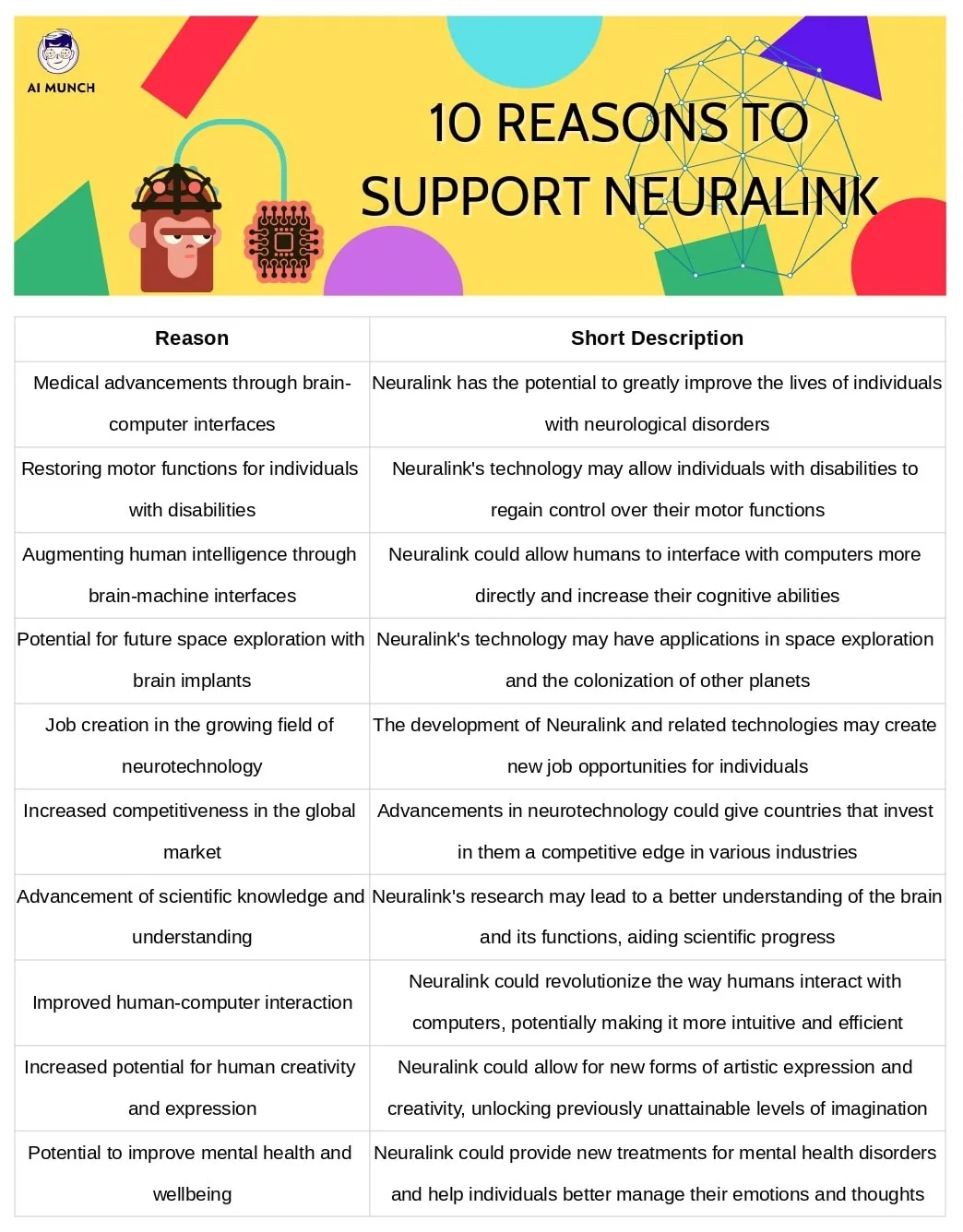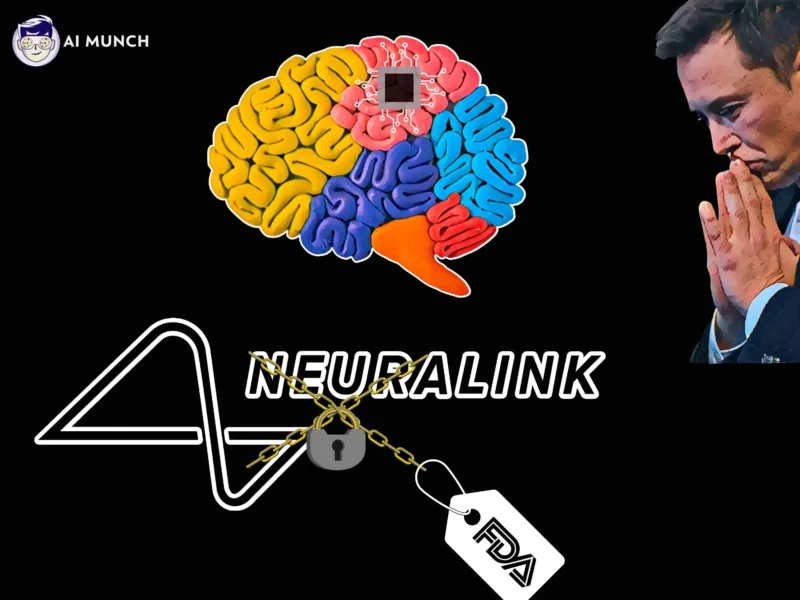I. Introduction
Elon Musk, the CEO of Tesla, and other leaders in neuroscience and technology started Neuralink in 2016. The company’s mission is to create brain-machine interfaces (BMIs) that improve human-machine communication. Neural lace refers to implantable hardware that can read and transmit neural signals to a computer, and it is at the heart of this technology.
Why Support Neuralink
It’s crucial to back Neuralink because their tech could completely change the way we communicate and interact with machines and each other. This technology can improve medicine, space travel, and artificial intelligence by making it easier and more natural for people and machines to talk to each other.
In the past, we have already read what exactly Neuralink is and its benefits for the community. In this article, we’ll look at the arguments in favor of Neuralink and some of the concerns and criticisms raised about the technology. The report will also cover the potential uses and effects of Neuralink’s BMIs on various sectors of the economy and culture.
II. Understanding Neuralink
Background on Neuralink and its founder
In the words of Elon Musk, Elon Musk, Neuralink’s founder and CEO, is a well-known businessman who founded Tesla and SpaceX. In 2016, he established Neuralink to create AI-human fusion technology.
How Neuralink works
Using Neuralink’s technology, tiny electrodes called “threads” are implanted into the brain to detect and transmit neural signals to a computer. A neurosurgeon inserts the threads into the brain using a tiny robot. The objective is to develop a brain-machine interface that is both noninvasive and accurate.
Potential benefits of Neuralink technology
Many different fields and uses could benefit from Neuralink’s brain-machine interfaces. Paralyzed people or those with other motor function impairments may benefit from this technology by regaining some or all of their mobility. AI and VR may be able to get better if people and machines can talk to each other more naturally. That’s why AI is helping the metaverse. The technology may also be applied to studying and treating neurological conditions like epilepsy and Parkinson’s disease.
III. Reasons to Support Neuralink
A. Medical Advancements
- Brain-Computer Interfaces
Making life better for people with neurological disorders is one of the most exciting potential uses for Neuralink’s technology by creating brain-computer interfaces (BCIs). People who are paralyzed or have other motor function impairments may be able to use brain-computer interfaces (BCIs) to operate prosthetics, wheelchairs, and computers using only their thoughts. This has the potential to enhance their autonomy and quality of life significantly.
- Restoring motor functions
Neuralink’s technology also has the potential to restore motor functions for individuals with disabilities. By implanting electrodes into the brain and using them to bypass damaged or non-functional areas, Neuralink’s technology could help individuals regain control over their movements and possibly even restore lost senses.
B. Technological Advancements
- Augmenting human intelligence
Neuralink’s technology could help people become much brighter in the future by letting them connect with their computers and other machines more personally. This may have far-reaching effects in many areas, including teaching, science, and business. For instance, scientific advancements in fields like brain-computer interfaces and machine learning may benefit from using BCIs by researchers.
- Potential for future space exploration
Space travel and the colonization of other planets may benefit from Neuralink’s technological advancements. Neuralink’s technology could improve the speed and accuracy of space missions by making it easier for people and machines to talk to each other. Also, the technology might make it easier for astronauts to do complex tasks and run machines in space.
C. Economic Advancements
- Job Creation
The development of Neuralink and related technologies could create new job opportunities in the growing field of neurotechnology. These jobs could range from engineers and technicians to researchers and medical professionals. This could help stimulate the economy and create a new industry that is poised for growth.
- Increased competitiveness in the global market
Economies that put money into neurotechnology may see gains across the board. Improvements in medicine, AI, and space travel are all possibilities. Countries that put money into Neuralink and other companies like it will become world leaders in this exciting new industry.
Finally, the potential medical, technological, and economic benefits of backing Neuralink cannot be overstated. Individuals, businesses, and governments that put money into brain-machine interface research and development will be able to shape the future of humanity.

IV. Criticisms and Concerns
A. Ethical concerns
AI has dark sides as well. One of the most significant ethical worries about Neuralink’s technology is that it could improve people’s abilities in ways that aren’t natural or acceptable. This could create a new class of “superhumans” with unfair advantages over others. Concerns have also been raised about how technology could be abused, such as by making mind-reading devices that could invade people’s privacy.
B. Privacy concerns
As Neuralink’s technology involves the implantation of devices directly into the brain, there are concerns about the potential for privacy violations. This could include the unauthorized access or manipulation of an individual’s thoughts or actions and the collection and misuse of sensitive personal data.
C. Safety concerns
Implanting devices into the brain also raises safety concerns. There is a risk of infection or other complications associated with invasive procedures. Additionally, there are concerns about the long-term effects of having electrodes implanted in the brain, as well as the potential for the devices to
V. Addressing Criticisms and Concerns
A. Address Ethical concerns
Neuralink has promised to build its tech socially and morally responsibly. They’ve set up an ethics board to ensure their tech is ethical, and they’ve committed to following guidelines like “informed consent” and “non-discrimination” in their work.
B. Address Privacy concerns
Neuralink has promised to use strong encryption and security measures to ease users’ worries about the privacy of their personal information. They have also said that they will be open and honest about how they collect and use people’s data and will get people’s permission first and follow it.
C. Address Safety concerns
Neuralink has said they are collaborating with government bodies and medical experts to make their technology as safe as possible. They are committed to addressing any issues that may arise and are conducting extensive testing and monitoring to ensure the safety and efficacy of their devices.
VI. Conclusion
In conclusion, there are many compelling arguments in favor of backing Neuralink. This company’s state-of-the-art brain-computer interfaces have the potential to alter the way we live fundamentally. The technology could help improve health care, boost the economy, and give people new creative thinking methods. Neuralink has its critics, such as FDA, but these worries can be put to rest with planning and regulation.
Final thoughts on the future of Neuralink technology
Neuralink technology has a bright and promising future. As the company puts more money into developing its brain-computer interfaces, we can expect them to be used in cutting-edge ways. This technology could be used for almost anything, from helping people with disabilities to having telepathic conversations. New treatments for neurodegenerative diseases like Alzheimer’s and Parkinson’s may also be developed with the help of Neuralink technology.
Looking ahead, it’s evident that investing in Neuralink’s R&D efforts is essential. Assisting innovative U.S. businesses like Neuralink is one way to keep the country at the cutting edge of technology and ensure that American inventors keep pushing the envelope. This can be done by asking the government for money and putting money into businesses working on complementary technologies. It’s also essential to keep up with Neuralink developments and participate in public debates about the pros and cons of the technology. By collaborating, we can ensure that Neuralink’s future is bright and full of promise.
Dear Food and Drug Administration (FDA), We eat grains, fruits, vegetables, and meat; we still get sick. Does this mean we should stop eating them? ‘NO’. In the same way, (Think of those who can’t see or move) if Neuralink can do good things for us, we should support this; of course, there will be side effects, but I am sure Elon Musk will find a way to eliminate those.
FAQs
Neuralink is still in the testing phase and is not available to the general public. However, the company has stated that they plan to make the technology available to people with certain medical conditions in the future.
For Neuralink to function, tiny electrodes for sensing and transmitting neural activity from the brain to an external device are implanted there. The information collected by these electrodes is sent to a computer or other device through a wireless device implanted behind the ear.
Neuralink connects to the brain by implanting small electrodes directly into the brain tissue. These electrodes can detect and record neural activity, which can then be transmitted to an external device for analysis.
While Neuralink has conducted some initial testing on animals, human trials have not yet begun. The company has stated that they plan to begin testing on humans in the near future, but this will require approval from regulatory agencies and the completion of additional safety testing.
Neuralink could help people with paralysis regain mobility by letting them use their minds to operate prosthetic limbs or other devices. Neuralink can pick up on movement-related neural activity by implanting electrodes directly into the brain. It can then use this information to control external devices.
As of March 2023, Neuralink has not yet begun human testing. The company has conducted initial testing on animals and is working to obtain regulatory approval for human trials. Recently, FDA disapproved their request for human trials.
Do you want to read more? Check out these articles.











I love your blog.. very nice colors & theme. Did you design this website yourself or
did you hire someone to do it for you? Plz respond as I’m looking to
design my own blog and would like to know where u got this from.
kudos
I used the Networker Premium theme and made a few changes.
Heya i’m for the first time here. I came across this board and I find It really useful & it helped me out much.
I hope to give something back and aid others like you helped me.
ok,,thanks